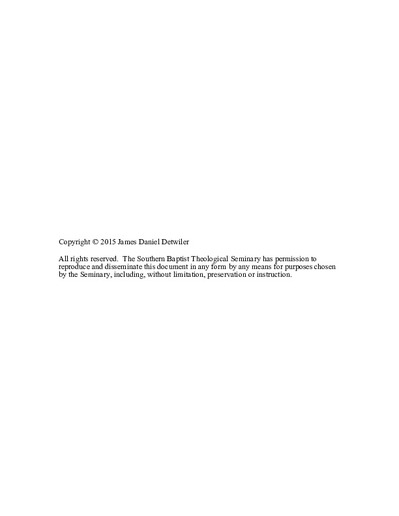| dc.description.abstract | This dissertation examines sermon application in the doctrinal preaching of John Piper. The work argues that Piper’s use of application is characterized by multifaceted purpose and the qualities of consistency, creativity, clarity, recurrence, cumulative and/or climactic effect, and contextualization. The critical model utilized involves three primary components: quality, purpose, and doctrine. A representative sample of 700 sermons is analyzed, spanning Piper’s thirty-plus years in the pulpit.
Chapter 1 clarifies the thesis, presents an overview of the dissertation’s methodology, and provides research delimitations and background information. Attention is given to the motivations behind the research and the importance of the study.
Chapter 2 presents biographical material so that the reader may better understand and appreciate Piper’s practice in the pulpit. His identity as a person, pastor-theologian, and preacher is explored.
Chapter 3 addresses the process of study, surveying selected literature on doctrinal preaching and sermon application. Key terms such as doctrinal preaching and sermon application are defined. Moreover, the vital connection between doctrinal preaching and sermon application is demonstrated.
Chapter 4 discusses the study’s methodology and describes in detail both the object and method of analysis. The critical model employed, which guided the research, is thoroughly discussed, including the six qualities of sermon application (consistency, creativity, clarity, recurrence, cumulative and/or climactic effect, and contextualization), the four purposes of sermon application (duty, character, goals, and discernment), and the doctrines applied.
Chapter 5 presents a segregated analysis of Piper’s preaching utilizing the critical model described in chapter 4. Research findings are thoroughly discussed, in terms of the six qualities, four purposes, and doctrines applied.
Chapter 6 presents an integrated analysis of Piper’s doctrinal preaching. Patterns of quality, purpose, doctrine, and co-occurrence are emphasized. Also, the interplay of quality, purpose, and doctrine is demonstrated. Furthermore, development over time and across select sermon series is assessed.
Chapter 7 concludes the project, presenting a summary of findings, key insights, major implications, and suggestions for future research. Defining characteristics of Piper’s method are outlined, specifically in terms of the six qualities, the four purposes, and the doctrines applied. | en_US |

